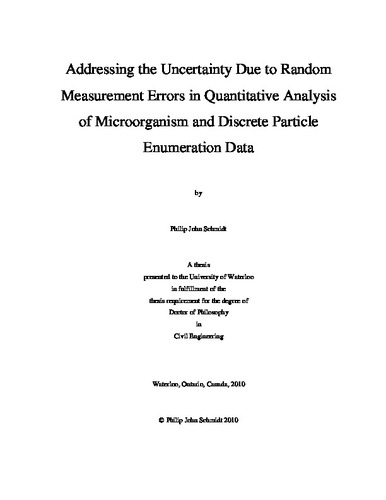| dc.description.abstract | Parameters associated with the detection and quantification of microorganisms (or discrete particles) in water such as the analytical recovery of an enumeration method, the concentration of the microorganisms or particles in the water, the log-reduction achieved using a treatment process, and the sensitivity of a detection method cannot be measured exactly. There are unavoidable random errors in the enumeration process that make estimates of these parameters imprecise and possibly also inaccurate. For example, the number of microorganisms observed divided by the volume of water analyzed is commonly used as an estimate of concentration, but there are random errors in sample collection and sample processing that make these estimates imprecise. Moreover, this estimate is inaccurate if poor analytical recovery results in observation of a different number of microorganisms than what was actually present in the sample. In this thesis, a statistical framework (using probabilistic modelling and Bayes’ theorem) is developed to enable appropriate analysis of microorganism concentration estimates given information about analytical recovery and knowledge of how various random errors in the enumeration process affect count data. Similar models are developed to enable analysis of recovery data given information about the seed dose. This statistical framework is used to address several problems: (1) estimation of parameters that describe random sample-to-sample variability in the analytical recovery of an enumeration method, (2) estimation of concentration, and quantification of the uncertainty therein, from single or replicate data (which may include non-detect samples), (3) estimation of the log-reduction of a treatment process (and the uncertainty therein) from pre- and post-treatment concentration estimates, (4) quantification of random concentration variability over time, and (5) estimation of the sensitivity of enumeration processes given knowledge about analytical recovery. The developed models are also used to investigate alternative strategies that may enable collection of more precise data. The concepts presented in this thesis are used to enhance analysis of pathogen concentration data in Quantitative Microbial Risk Assessment so that computed risk estimates are more predictive. Drinking water research and prudent management of treatment systems depend upon collection of reliable data and appropriate interpretation of the data that are available. | en |

